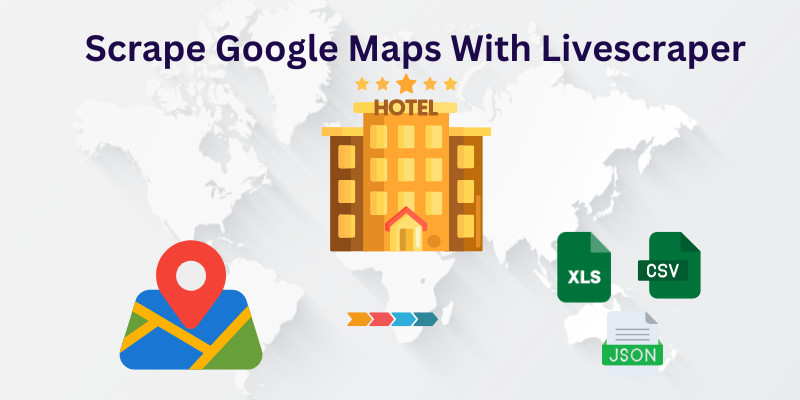Table of Contents
Google Maps: How to Scrape Businesses Without Websites
Data scraping, a process that automates the extraction of data from websites, is epitomized by the Google Maps Data Scraping service offered by Livescraper. This service is particularly beneficial for those aiming to offer services to businesses that lack an online presence. While the global count of websites stands at 1.13 billion, only a select number are maintained with regular updates.
According to Statista, approximately 82% of websites are inactive, indicating that out of the 1.13 billion existing websites, only about 200 million are actively maintained and frequented1. This statistic highlights a significant opportunity for marketing experts and web designers to target businesses that either lack a website or require website maintenance.
So, 18% of these websites are active, 82% are inactive.
The importance of a website for businesses and individuals cannot be overstated, despite the challenges in identifying companies without an online presence through standard online searches. Before exploring this further, it’s essential to understand why having a website is so vital in today’s digital landscape.
Understanding the Value of a Web Presence
- Trust and Credibility: Websites are essential tools for businesses, providing a foundation for establishing credibility and trust, which are vital for maintaining a strong online presence. Websites act as virtual storefronts or offices, accessible to everyone, allowing businesses to establish an online presence.
- Branding: Your website serves as a significant platform for brand growth, enhancing credibility and enabling effective online promotion. It provides an opportunity to establish and reinforce brand identity through consistent branding efforts such as the use of logos, colors, and messaging, creating a memorable and unified brand experience for customers.
- Attracting and Retaining Customers: With valuable information exchange, exceptional customer service, and round-the-clock accessibility, the website captivates and retains customers. This accessibility enables potential customers to conveniently access information about your business whenever they choose.
- Lead Generation & Marketing: Websites provide a potent platform for lead generation, sales stimulation, and cost-saving through efficient advertising. Harnessing this robust marketing tool allows businesses to expand their reach and engage a broader audience through multiple online channels, including search engines, social media platforms, email marketing, and digital advertising initiatives.
- Customer Support and Engagement: Through blog posts, newsletters, FAQs, contact forms, live chats, and social media integration, a website offers a comprehensive platform for meaningful engagement with your audience. This website enables timely customer support and efficient handling of inquiries and concerns, fostering positive customer interactions.
- E-commerce Capabilities: An e-commerce website empowers businesses with the ability to conduct transactions online, irrespective of geographical boundaries. By providing a seamless platform for buying and selling products or services, it extends the reach of businesses, unlocking new revenue opportunities and enabling them to cater to a global audience.
- Analytics and Insights: Analytic tools, such as Google Analytics, provide extensive insights into user behavior, preferences, and demographics through website tracking. This valuable data serves as a vital compass for decision-making related to marketing strategies, content development, and website optimization, aiming to enhance overall effectiveness and performance.
Why Some People Look for Businesses That Don’t Have Websites
So, why do people search for businesses without websites? Let’s break it down. A lot of the time, it’s people in the digital marketing world who are looking for these businesses—like marketing experts, photographers, and website designers.
Here are a few reasons why website designers and marketers are on the lookout for businesses that don’t have websites yet:
- Opportunity for New Clients: Designers have the opportunity to gain potential clients by targeting businesses without websites. These businesses represent a market where designers can offer their services, helping them establish an online presence.
- Networking and Referrals: Designers frequently collaborate and network with other professionals, including marketing consultants, business coaches, and industry associations. These professionals often encounter businesses in need of website development services during their interactions. As a result, these contacts can serve as a valuable source of referrals for designers, connecting them with potential clients who require website design and development solutions.
- Market Demand: The increasing reliance on digital platforms has fueled a persistent demand for website design services, as businesses acknowledge the pivotal role of a strong online presence in the modern business landscape Educational Outreach: As part of their outreach efforts, website designers might educate businesses that lack an online presence about the advantages of having a well-designed website. They can explain how a professional website can enhance the company’s visibility, credibility, and customer engagement, ultimately contributing to business growth.
- Social Media and Online Forums: Website designers proactively engage with business owners through social media groups, forums, and online communities. This participation allows designers to pinpoint businesses lacking an online presence, presenting an opportunity to fill this gap and offer their website design services.
- Local Market Research: To uncover business opportunities, designers and digital marketing agency professionals often engage in local market research to pinpoint businesses within their geographical vicinity that currently lack a web presence.
In their client acquisition strategy, website designers and marketing experts actively identify and approach businesses lacking an online presence. Recognizing the need for a professional and effective website, they present their services to help businesses establish a robust online platform.
In their client acquisition strategy, website designers proactively identify businesses lacking an online presence. Recognizing the need for a professional and effective website among these businesses, designers offer their expertise to assist them in establishing a robust online presence.
How to Use Google Maps to Extract Company Information
With an understanding of the significance of having a website, we can move forward. Our next step involves identifying potential customers, particularly businesses without an online presence. By doing so, we aim to offer our digital marketing services or web development solutions, catering to their specific needs.
Extracting business information from entities without websites involves strategies like search engine scraping, social media scraping, API utilization, local directory scraping, public records search, data aggregators, and crowdsourcing.
Scraping business information can be a demanding and stressful task, requiring technical expertise and consuming a significant amount of time. Instead of relying on these complex strategies, we present an effortless and cost-effective solution to finding businesses without websites in a specific U.S city. Our approach simplifies the process, enabling you to reach your goals with ease.
Google Maps, a web mapping service offered by Google, provides extensive mapping capabilities. It features interactive maps, satellite imagery, street views, real-time traffic updates, and route planning for various modes of transportation, including driving, walking, biking, and public transportation. The public data available through Google Maps can be utilized for scraping activities using the Livescraper platform.
Among businesses, Google Maps provides a valuable platform for creating listings that include key information such as address, phone number, website, operating hours, and customer reviews. This enables potential customers to conveniently discover and
Google Business allows businesses to connect with potential customers via phone calls. Maximizing phone data is advantageous as the service prioritizes phone data over email data. Web developers and marketers can offer their services to businesses not listed on Google Business, enhancing online presence and improving SEO.
Using Livescarper’s Google Maps Data Scraper
So, we’ve talked about why having a website is important and why marketers and website designers are always looking for businesses that don’t have one. Now, let’s take a look at the tools that make it easy to get data from Google Maps using Livescraper’s Google Maps Data Scraper.
Among the services offered by Livescraper, the Google Maps Data Scraper stands out as a well-known choice. This web service allows users to extract data from Google Maps by specifying specific categories and locations of interest. Livescraper boasts a user-friendly interface, making the data scraping process effortless and accessible to users.
How to Extract Business Data Without Websites Using Livescraper: A Step-by-Step Tutorial
1. Don’t forget to create a Livescraper account to enjoy the company’s 10% discount. If you already have an account, great! Proceed to the next steps by selecting the Google Maps Data Scraper.
2. Select the Category from the drop-down menu, or you can Check all Categories for your reference. There’s also an option for Plain Queries, where you can toggle to turn it on or off. We will use the drop-down menu in the Categories for this tutorial.
We will be using Pet Store as our Category because we will be utilizing Google Maps Data Scraper to get the list of Pet Stores in San Francisco, California, who don’t have their own website so that you can offer your service as a digital marketer and website designer
Alright, so you’ve got two categories: “Pet Store” and “Pet Shop.” That makes sense because different countries use different names for them. Just check which category is more commonly used in your country and select that one.
3. To begin, we’ll select the “Pet store” category. Next, we’ll choose California for the state and San Francisco for the city. While there’s an option for custom locations, we’ll stick with the basics for now.
4. Specify the maximum number of results that you want to receive, up to a limit of 500. Note that if you enter zero (0), you’ll receive unlimited results.
5. When enriching the data, you can scrape a limited number of fields from Google Maps. Additionally, you can enrich the data by using email scraping services. Under the Emails section, you can ignore records without emails, and delete duplicate emails.
6. To use advanced search parameters, select the “Advanced Parameters” option. Sometimes, Google adds additional categories that are not relevant to your search. Using filters, you can exclude these unrelated categories and only focus on the relevant results. To do this, click on the “Add” button, and a pop-up window with various fields will appear. In the “Field” field, select “Website,” and in the “Operator” field, choose “is blank.” Finally, click on the “Save” button to apply these settings.
7. Next, you can select the language and places per query; we recommend using 500. To increase your search coverage, check the “Delete duplicates” and “Use Zip codes” options. Keep in mind that Google only shows up to 500 places per search query, so the “Use Zip codes” option can help expand your search coverage.
8. For downloading the files, you may select from various formats such as XLSX, CSV, or JSON. Task Tags are also available for convenient identification. To proceed, simply click on the Get Data option.
9. Scraping data from Livescraper may take a few minutes, depending on the volume of data you want to extract from Google Maps. In our experience, extracting a list of real estate agencies in San Francisco, California, that lack a website took approximately 7 to 10 minutes. The data was then downloaded to our computer. Below is a screenshot of the downloaded data, based on the filters and information we provided earlier in this guide.
Conclusion
With Google Maps Scraping services like Livescraper, website designers and marketers have a powerful tool at their disposal. This is especially beneficial for businesses in the real estate industry that lack their own websites. Livescraper, the industry leader, provides invaluable data that can be used to reach potential clients effectively.
With the capabilities of Livescraper, professionals can easily find and contact real estate agencies that don’t have a website. This saves time, money, and effort in lead generation and allows website designers to offer their services in creating custom websites for these agencies. Marketers can use Livescraper’s verified and up-to-date data to develop targeted strategies to engage potential homebuyers and sellers who rely on websites to search for properties.
In a competitive marketplace, website designers and marketers can leverage the services of Google Maps scraping tools like Livescraper to create valuable partnerships with pet store owners. This strategic alliance can drive growth and success by providing valuable insights into market trends, property data, and consumer behavior.


